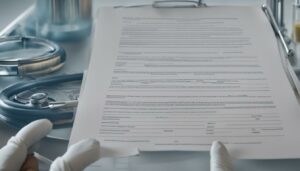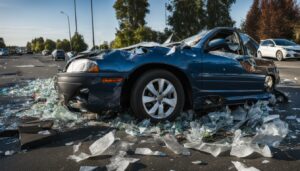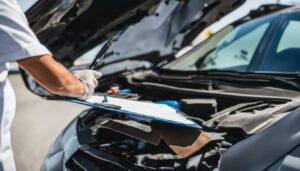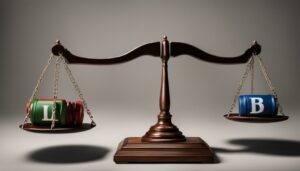Proving fault in personal injury accidents can be a complex process that requires a thorough understanding of the general rules surrounding liability and negligence. When determining fault in a personal injury case, it hinges on whether someone acted carelessly or negligently, resulting in the accident or injury. Various rules come into play, such as trespassing and assumption of risk, comparative negligence, employer liability for employee negligence, dangerous conditions on property, liability for defective products, and joint and several liability.
In most states, the injured party’s own fault may also impact their claim, with comparative negligence rules in place. To navigate these intricacies and increase the chances of a successful claim, it is crucial to consult with an experienced personal injury lawyer who can guide you through the process.
Key Takeaways:
- Proving fault in personal injury accidents involves understanding the general rules of liability and negligence.
- Fault determination in personal injury cases considers various factors, such as trespassing and assumption of risk, comparative negligence, and liability for dangerous conditions on property or defective products.
- The injured party’s own fault may affect their claim, with comparative negligence rules in place in most states.
- Consulting with an experienced personal injury lawyer is crucial to navigate the complexities of proving fault in personal injury cases.
Understanding Legal Liability and Negligence
To prove fault in personal injury accidents, it is essential to understand the concepts of legal liability and negligence. Legal liability refers to the responsibility of individuals to act in a reasonable and prudent manner to avoid causing harm to others. Negligence, on the other hand, involves careless or negligent actions that result in harm. In simple terms, if one person involved in an accident was less careful than another, they may be held liable for the damages suffered by the more careful party.
Related Post: Personal Injury Cases – The Process
When determining liability, various factors come into play. These include trespassing, assumption of risk, and comparative negligence. Trespassing refers to someone unlawfully entering another person’s property, which can affect the liability in a personal injury case. Assumption of risk occurs when an individual voluntarily engages in an activity with known risks. Comparative negligence compares the degree of fault between the parties involved in the accident.
Understanding legal liability and negligence is crucial when proving fault in personal injury accidents. It allows individuals to navigate the complexities of personal injury cases and seek compensation for their injuries and damages.
Key points:
- Legal liability and negligence are key factors in proving fault in personal injury accidents.
- Legal liability refers to the responsibility to avoid causing harm to others.
- Negligence involves careless or negligent actions that result in harm.
- Factors such as trespassing, assumption of risk, and comparative negligence influence liability determination.
- Understanding legal liability and negligence is essential to navigate personal injury cases and seek compensation.
Table: Comparative Negligence Rules by State
| State | Comparative Negligence Rule |
|---|---|
| Alabama | Contributory negligence: If the injured party is even slightly at fault, they may be barred from recovering compensation. |
| California | Pure comparative negligence: The injured party can recover compensation even if they are 99% at fault, but their recovery award will be reduced by their percentage of fault. |
| Florida | Pure comparative negligence: The injured party can recover compensation even if they are mostly at fault, but their recovery award will be reduced by their percentage of fault. |
| Texas | Modified comparative negligence: The injured party can recover compensation if they are 50% or less at fault, but their recovery award will be reduced by their percentage of fault. |
Dangerous Conditions and Liability in Personal Injury Cases
Dangerous conditions on property and liability for defective products are two key factors that can significantly impact the determination of fault in personal injury cases. When someone sustains an injury due to unsafe conditions on a property or a defective product, multiple parties may be held liable for the damages caused. This can lead to the concept of joint and several liability, where the injured party can seek compensation from any one or more of the responsible parties.
In the case of dangerous conditions on a property, the owner or occupier may be held liable if they failed to maintain the property in a safe condition. This can include situations where there are hazardous obstacles, inadequate security measures, or poorly maintained premises. To establish liability, it is crucial to gather evidence such as photographs, witness statements, and any relevant documentation that demonstrates the dangerous conditions.
Similarly, liability for defective products can arise when a product is designed, manufactured, or marketed in a way that poses a risk to consumers. In these cases, both the manufacturer and seller may be held liable for any injuries or damages caused by the faulty product. It is essential to gather evidence such as product specifications, records of tests and inspections, and any relevant documentation to establish liability for defective products.
Dangerous Conditions on Property – Example
Table: Example of Dangerous Conditions on Property
| Dangerous Condition | Description | Evidence |
|---|---|---|
| Uneven Pavement | Cracked or uneven pavement that poses a tripping hazard | Photographs, witness statements, maintenance records |
| Insufficient Lighting | Inadequate lighting that increases the risk of accidents or criminal activity | Photographs, witness statements, police reports |
| Faulty Staircases | Staircases with broken steps or damaged handrails | Photographs, maintenance records, expert analysis |
In cases where dangerous conditions or defective products result in personal injury, it is crucial to consult with an experienced personal injury lawyer. They can help navigate the complexities of proving fault and ensure that all necessary evidence is gathered and presented effectively. With their expertise, injured parties can maximize their chances of obtaining fair compensation for their injuries and damages.
Comparative Negligence and Its Impact on Liability
When it comes to proving fault in personal injury cases, understanding comparative negligence is crucial. Comparative negligence refers to a legal concept that comes into play when the injured party is also found to be at fault to some extent. In such cases, the amount of personal injury compensation the injured party may receive can be reduced by the percentage of their own liability.
There are three different types of comparative negligence rules that vary by state: pure comparative negligence, modified comparative negligence, and contributory negligence. Under pure comparative negligence, the injured party can recover compensation even if they are 99% at fault, but the compensation amount will be reduced proportionately to their fault. Modified comparative negligence, on the other hand, imposes a threshold beyond which the injured party cannot recover compensation if they are more than a certain percentage at fault. Contributory negligence bars the injured party from receiving any compensation if they are found even slightly at fault.
Understanding how comparative negligence rules apply in your state is essential for determining the potential impact on liability and personal injury compensation. It is important to consult with an experienced personal injury lawyer who can navigate the complexities of comparative negligence and fight for your rights to fair compensation.
Comparative Negligence at a Glance
| Comparative Negligence Rule | Description |
|---|---|
| Pure Comparative Negligence | The injured party can recover compensation even if they are majority at fault, but the compensation amount will be reduced proportionately to their fault. |
| Modified Comparative Negligence | The injured party can recover compensation if they are less than a certain percentage at fault. Beyond that threshold, they cannot recover any compensation. |
| Contributory Negligence | The injured party cannot recover any compensation if they are found even slightly at fault. |
Comparative negligence can significantly impact the outcome of a personal injury claim. It is important to gather strong evidence and present a compelling case to prove the extent of the other party’s fault and minimize your own liability. Your personal injury lawyer will play a key role in assessing comparative negligence and advocating for your rights to fair compensation.
Understanding Duty of Care and Breach of Duty
When it comes to proving fault in personal injury cases, understanding the concepts of duty of care and breach of duty is essential. Duty of care refers to the legal obligation to act in a reasonable and prudent manner to avoid causing harm to others. It is a standard that applies to various situations, such as driving a vehicle, maintaining property, or providing medical treatment. The duty of care can vary depending on the circumstances and the relationship between the parties involved.
Breach of duty, on the other hand, occurs when someone fails to fulfill their duty of care. It means that they have not acted in a reasonable and prudent manner, resulting in harm or injury to another person. In personal injury cases, establishing a breach of duty requires demonstrating that the responsible party’s actions or omissions fell below the expected standard of care.
“The duty of care is the cornerstone of personal injury claims. It holds individuals and entities accountable for their actions and ensures that negligence does not go unpunished.”
Professional negligence is a specific type of breach of duty that applies to professionals, such as doctors, lawyers, or accountants. These professionals have a higher standard of care due to their specialized knowledge and expertise. Proving professional negligence involves showing that the professional failed to act in accordance with the accepted standard of care within their field.
Examples of Duty of Care and Breach of Duty:
| Situation | Duty of Care | Breach of Duty |
|---|---|---|
| Medical Treatment | To provide competent and appropriate medical care | To misdiagnose a condition or administer the wrong medication |
| Property Maintenance | To keep the property safe and free from hazards | To neglect repairs, leading to accidents or injuries |
| Driving a Vehicle | To follow traffic laws and drive safely | To speed, drive under the influence, or engage in reckless behavior |
Understanding duty of care and breach of duty is crucial in personal injury claims. It helps establish the legal responsibility of the at-fault party and forms the basis for seeking compensation for the injuries and damages suffered.
Establishing Causal Link and Damages in Negligence Claims
When it comes to proving fault in personal injury accidents, establishing a causal link and demonstrating the damages suffered by the plaintiff are crucial elements. A causal link refers to showing that the defendant’s breach of duty directly caused the injuries and harm experienced by the plaintiff. This can be accomplished through a combination of evidence, such as video surveillance, witness statements, and medical records.
Once the causal link has been established, it is important to demonstrate the damages incurred as a result of the injuries. This involves showing the monetary losses experienced by the plaintiff, including medical expenses, lost wages, and rehabilitation costs. Additionally, non-economic damages such as pain and suffering may also be considered.
“The defendant’s negligence led directly to my injuries, and the medical bills and lost wages have caused significant financial strain for me and my family,” stated John, a personal injury victim.
Proving the causal link and damages in a negligence claim requires gathering strong evidence and presenting it effectively. This may involve seeking expert opinions, such as testimony from accident reconstructionists or medical professionals, to support the claim. By building a compelling case, plaintiffs can enhance their chances of obtaining a favorable outcome in their personal injury lawsuit.
| Causal Link | Damages |
|---|---|
| Show that the defendant’s breach of duty caused the injuries | Demonstrate the monetary losses suffered by the plaintiff |
| Utilize evidence such as video surveillance and witness statements | Include medical expenses, lost wages, and rehabilitation costs |
| Seek expert opinions and testimonies | Consider non-economic damages like pain and suffering |
Types of Evidence for Establishing Negligence
In personal injury cases, gathering strong evidence is essential for establishing negligence and proving fault. By presenting compelling evidence, you can strengthen your claim and increase your chances of obtaining fair compensation. Here are some types of evidence commonly used to establish negligence:
- Accident Scene Evidence: Photographs, sketches, or videos of the accident scene can provide valuable insights into the conditions that led to the incident. These visuals can help recreate the sequence of events and demonstrate negligence.
- Surveillance Footage: If there were security cameras in the vicinity of the accident, obtaining surveillance footage can provide objective evidence of what transpired. This can be particularly useful in cases where liability is in dispute.
- Witness Statements: Statements from eyewitnesses who saw the accident occur can provide crucial firsthand accounts. These testimonies can corroborate your version of events and lend credibility to your claim.
- Medical Records: Detailed medical records documenting your injuries, treatments, and prognosis can establish the extent and severity of your damages. They can also establish a direct link between the accident and your injuries.
Remember, the strength of your evidence can significantly impact the outcome of your negligence claim. It’s important to consult with a personal injury lawyer who can guide you in gathering and presenting the most compelling evidence to support your case.
| Evidence Type | Description |
|---|---|
| Accident Scene Evidence | Photographs, sketches, or videos of the accident scene. |
| Surveillance Footage | Recordings from security cameras in the vicinity of the accident. |
| Witness Statements | Testimonies from eyewitnesses who saw the accident occur. |
| Medical Records | Detailed documentation of injuries, treatments, and prognosis. |
The Role of Personal Injury Lawyers in Proving Fault
When it comes to proving fault in personal injury cases, the expertise of a personal injury lawyer is invaluable. A skilled attorney understands the intricacies of proving negligence, gathering evidence, and navigating the legal process. They play a crucial role in building a strong case and advocating for their clients’ rights.
Gathering evidence is a vital component of proving fault in personal injury accidents. Personal injury lawyers have the knowledge and resources to gather the necessary evidence to support their clients’ claims. This can include obtaining surveillance footage, collecting witness statements, and securing medical records that substantiate the injuries sustained. By meticulously assembling the evidence, personal injury lawyers strengthen their clients’ position in negotiations and potential legal proceedings.
Insurance companies often try to minimize the compensation they pay out to personal injury victims. Personal injury lawyers have extensive experience in negotiating with insurance companies to ensure their clients receive fair and just compensation. They understand the tactics used by insurance adjusters and can effectively advocate for their clients’ rights, taking into account the full extent of their injuries, damages, and financial losses.
In complex cases where evidence may be challenging to obtain, personal injury lawyers may employ other strategies to prove fault. This can include engaging expert testimonies from accident reconstruction experts or medical professionals to strengthen the case and provide additional support for the negligence claim. By leveraging their network of experts, personal injury lawyers bolster their clients’ chances of proving fault and obtaining the compensation they deserve.
The Concept of Liability in Florida Personal Injury Claims
In Florida, personal injury claims are centered around the concept of liability, which is based on proving negligence. Negligence refers to the failure to act in a reasonable and prudent manner, resulting in harm to another person. To establish liability and recover compensation in a Florida personal injury claim, it is necessary to demonstrate the negligence of the other party involved.
Proving negligence involves showing that the defendant owed the injured party a duty of care, that there was a breach of that duty, and that the breach directly caused the harm suffered by the plaintiff. Additionally, the plaintiff must demonstrate the resulting damages as a direct consequence of the defendant’s negligence.
Liability in personal injury cases is determined by examining the actions of the parties involved and assessing whether negligence played a role. If negligence is proven, the injured party may be entitled to compensation for medical expenses, lost wages, pain and suffering, and other damages resulting from the accident or injury.
| Duty of Care | Breach of Duty | Causal Link | Damages |
|---|---|---|---|
| To establish negligence, it is necessary to show that the defendant owed the injured party a legal duty of care. | The injured party must prove that the defendant breached this duty of care by acting negligently or carelessly. | The plaintiff must establish a direct causal link between the defendant’s breach of duty and the injuries suffered. | The plaintiff must demonstrate the damages suffered as a result of the accident or injury, such as medical expenses, lost wages, and pain and suffering. |
Successfully proving negligence and liability in a Florida personal injury claim is essential for obtaining fair compensation. Consulting with an experienced personal injury lawyer can provide invaluable guidance and support throughout the process, increasing the chances of a successful claim.
Elements of Negligence in Florida Personal Injury Claims
Proving fault in Florida personal injury claims requires establishing the elements of negligence. These elements include demonstrating the defendant’s duty of care, proving a breach of duty, establishing a causal link between the breach and the harm, and showing the resulting damages.
The duty of care is a legal obligation to act in a reasonable and prudent manner to avoid causing harm to others. Breach of duty occurs when this obligation is violated. To establish a breach of duty, it must be shown that the defendant failed to adhere to the standard of care expected in the given circumstances.
The next element is establishing a causal link. This requires demonstrating that the defendant’s breach of duty directly caused the injuries and damages suffered by the plaintiff. It is essential to establish a clear and direct connection between the defendant’s actions or negligence and the harm suffered.
The final element is proving damages. Damages refer to the physical, emotional, and financial losses suffered by the plaintiff as a result of the accident or injury. This can include medical expenses, lost wages, pain and suffering, and other related costs.

| Element of Negligence | Description |
|---|---|
| Duty of Care | The legal obligation to act in a reasonable and prudent manner to avoid causing harm to others. |
| Breach of Duty | A failure to adhere to the standard of care expected in the given circumstances. |
| Causal Link | A clear and direct connection between the defendant’s actions or negligence and the harm suffered by the plaintiff. |
| Damages | The physical, emotional, and financial losses suffered by the plaintiff as a result of the accident or injury. |
Evidence and Proof Required for Negligence Claims in Florida
When pursuing a personal injury lawsuit in Florida, gathering strong evidence is crucial to prove negligence and establish fault. The following types of evidence are essential for building a compelling case:
- Video Surveillance: Video footage from surveillance cameras at the accident scene can provide crucial visual evidence of the incident, capturing the actions of all parties involved.
- Witness Statements: Statements from eyewitnesses who saw the accident occur can provide valuable testimonies that support your version of events.
- Medical Records: Detailed medical records documenting your injuries, treatment, and prognosis are essential for proving the extent of your damages and connecting them to the accident.
In addition to these key pieces of evidence, hiring accident reconstructionists can further strengthen your case. Accident reconstruction experts analyze various factors, such as skid marks, vehicle damage, and road conditions, to recreate the accident and demonstrate fault.
“Video surveillance, witness statements, and medical records are crucial pieces of evidence required to establish negligence in a personal injury lawsuit.”
By presenting a comprehensive collection of evidence, including video surveillance footage, witness statements, and medical records, you can bolster your claim and increase the likelihood of a successful outcome in your negligence claim.
| Evidence Type | Description |
|---|---|
| Video Surveillance | Visual footage capturing the accident scene and the actions of all parties involved. |
| Witness Statements | Testimonies from individuals who witnessed the accident and can provide firsthand accounts of what occurred. |
| Medical Records | Official documentation of your injuries, treatment, and medical expenses, establishing the extent of your damages. |
| Accident Reconstructionists | Experts who analyze accident data to recreate the incident and provide expert opinions on fault and liability. |
Choosing a Skilled Personal Injury Lawyer for Proving Fault
When it comes to proving fault in personal injury cases, selecting the right personal injury lawyer is essential. A skilled attorney can make all the difference in successfully navigating a negligence claim and securing the compensation you deserve.
An experienced personal injury lawyer understands the intricacies of proving fault and has the expertise to gather compelling evidence. They will work diligently to uncover critical details and build a strong case on your behalf.
By enlisting the services of a knowledgeable attorney, you can rely on their guidance and expertise throughout the entire process. From negotiating with insurance companies to representing your interests in court, they will advocate for your rights and fight for fair compensation.
When it comes to your personal injury claim, don’t underestimate the importance of choosing an experienced personal injury lawyer. Their skills, knowledge, and dedication will significantly increase your chances of proving fault and obtaining the compensation you deserve for your injuries.
FAQ
What is the process for proving fault in personal injury accidents?
Proving fault in personal injury accidents involves understanding the general rules of liability and negligence. It requires establishing the duty of care, demonstrating a breach of duty, establishing a causal link, and showing damages.
What factors affect liability in personal injury cases?
Factors that can affect liability in personal injury cases include dangerous conditions on property, liability for defective products, multiple parties at fault, joint and several liability, and negligence in general.
How does comparative negligence impact liability?
Comparative negligence is a concept that considers the injured party’s own fault in determining liability. It can reduce the compensation awarded based on the percentage of the injured party’s fault.
What is duty of care and breach of duty?
Duty of care refers to the legal responsibility to act in a reasonable and prudent manner to avoid causing harm. Breach of duty occurs when this legal obligation is violated.
How do you establish a causal link and damages in a negligence claim?
Establishing a causal link requires demonstrating that the defendant’s actions directly caused the injuries. Damages must be shown to have resulted from the injuries and recovery process.
What types of evidence are needed to establish negligence?
Evidence such as video surveillance, photographs, witness statements, police reports, and medical records can help establish negligence in a personal injury claim.
What is the role of a personal injury lawyer in proving fault?
A personal injury lawyer helps identify the at-fault party, gathers evidence, and negotiates with insurance companies. They play a crucial role in preparing and presenting a strong claim.
How is liability determined in Florida personal injury claims?
In Florida, liability is determined by proving negligence. The injured party must demonstrate the other party’s failure to act with reasonable care or prudence.
What are the elements of negligence in Florida personal injury claims?
The elements of negligence in Florida personal injury claims include duty of care, breach of duty, causal link, and resulting damages.
What evidence is required for negligence claims in Florida?
Evidence such as video surveillance, witness statements, medical records, police reports, and expert testimonies may be required to establish negligence in a Florida personal injury lawsuit.
How do you choose the right personal injury lawyer to prove fault?
When selecting a personal injury lawyer, it is crucial to choose someone experienced in proving fault, gathering evidence, and negotiating with insurance companies. An experienced attorney can significantly enhance the chances of proving fault and obtaining fair compensation.










